General Solution of a First Order Separable Differential Equation In this problem, we want to find the general solution of the equation dy ry ,y >1 In y dr Part 1. After separating variables, we have: Jdy-dz Part 2. Next, we integrate both sides of the equation above with respect to the appropriate variables to get: Note: don't forget the differentials in your answer. Part 3. An antiderivative that results from the integral on the left hand side above is. NOTE: Type 'C1' for the arbitrary constant An antiderivative that results from the integral on the right hand side above is. NOTE: Type 'C2' for the arbitrary constant Part 4. Now, find the specific solution for which y = e when z = 4.
General Solution of a First Order Separable Differential Equation In this problem, we want to find the general solution of the equation dy ry ,y >1 In y dr Part 1. After separating variables, we have: Jdy-dz Part 2. Next, we integrate both sides of the equation above with respect to the appropriate variables to get: Note: don't forget the differentials in your answer. Part 3. An antiderivative that results from the integral on the left hand side above is. NOTE: Type 'C1' for the arbitrary constant An antiderivative that results from the integral on the right hand side above is. NOTE: Type 'C2' for the arbitrary constant Part 4. Now, find the specific solution for which y = e when z = 4.
Calculus: Early Transcendentals
8th Edition
ISBN:9781285741550
Author:James Stewart
Publisher:James Stewart
Chapter1: Functions And Models
Section: Chapter Questions
Problem 1RCC: (a) What is a function? What are its domain and range? (b) What is the graph of a function? (c) How...
Related questions
Question

Transcribed Image Text:General Solution of a First Order Separable Differential Equation
In this problem, we want to find the general solution of the equation
dy
ry
, y > 1
dr
In y
Part 1.
After separating variables, we have:
Jdy-dz
Part 2.
Next, we integrate both sides of the equation above with respect to the appropriate variables to get:
Note: don't forget the differentials in your answer.
Part 3.
An antiderivative that results from the integral on the left hand side above is.
NOTE: Type 'C1' for the arbitrary constant
An antiderivative that results from the integral on the right hand side above is.
NOTE: Type 'C2' for the arbitrary constant
Part 4.
Now, find the specific solution for which y = e when z = 4.
Expert Solution
This question has been solved!
Explore an expertly crafted, step-by-step solution for a thorough understanding of key concepts.
This is a popular solution!
Trending now
This is a popular solution!
Step by step
Solved in 4 steps with 4 images

Recommended textbooks for you

Calculus: Early Transcendentals
Calculus
ISBN:
9781285741550
Author:
James Stewart
Publisher:
Cengage Learning

Thomas' Calculus (14th Edition)
Calculus
ISBN:
9780134438986
Author:
Joel R. Hass, Christopher E. Heil, Maurice D. Weir
Publisher:
PEARSON

Calculus: Early Transcendentals (3rd Edition)
Calculus
ISBN:
9780134763644
Author:
William L. Briggs, Lyle Cochran, Bernard Gillett, Eric Schulz
Publisher:
PEARSON

Calculus: Early Transcendentals
Calculus
ISBN:
9781285741550
Author:
James Stewart
Publisher:
Cengage Learning

Thomas' Calculus (14th Edition)
Calculus
ISBN:
9780134438986
Author:
Joel R. Hass, Christopher E. Heil, Maurice D. Weir
Publisher:
PEARSON

Calculus: Early Transcendentals (3rd Edition)
Calculus
ISBN:
9780134763644
Author:
William L. Briggs, Lyle Cochran, Bernard Gillett, Eric Schulz
Publisher:
PEARSON

Calculus: Early Transcendentals
Calculus
ISBN:
9781319050740
Author:
Jon Rogawski, Colin Adams, Robert Franzosa
Publisher:
W. H. Freeman


Calculus: Early Transcendental Functions
Calculus
ISBN:
9781337552516
Author:
Ron Larson, Bruce H. Edwards
Publisher:
Cengage Learning